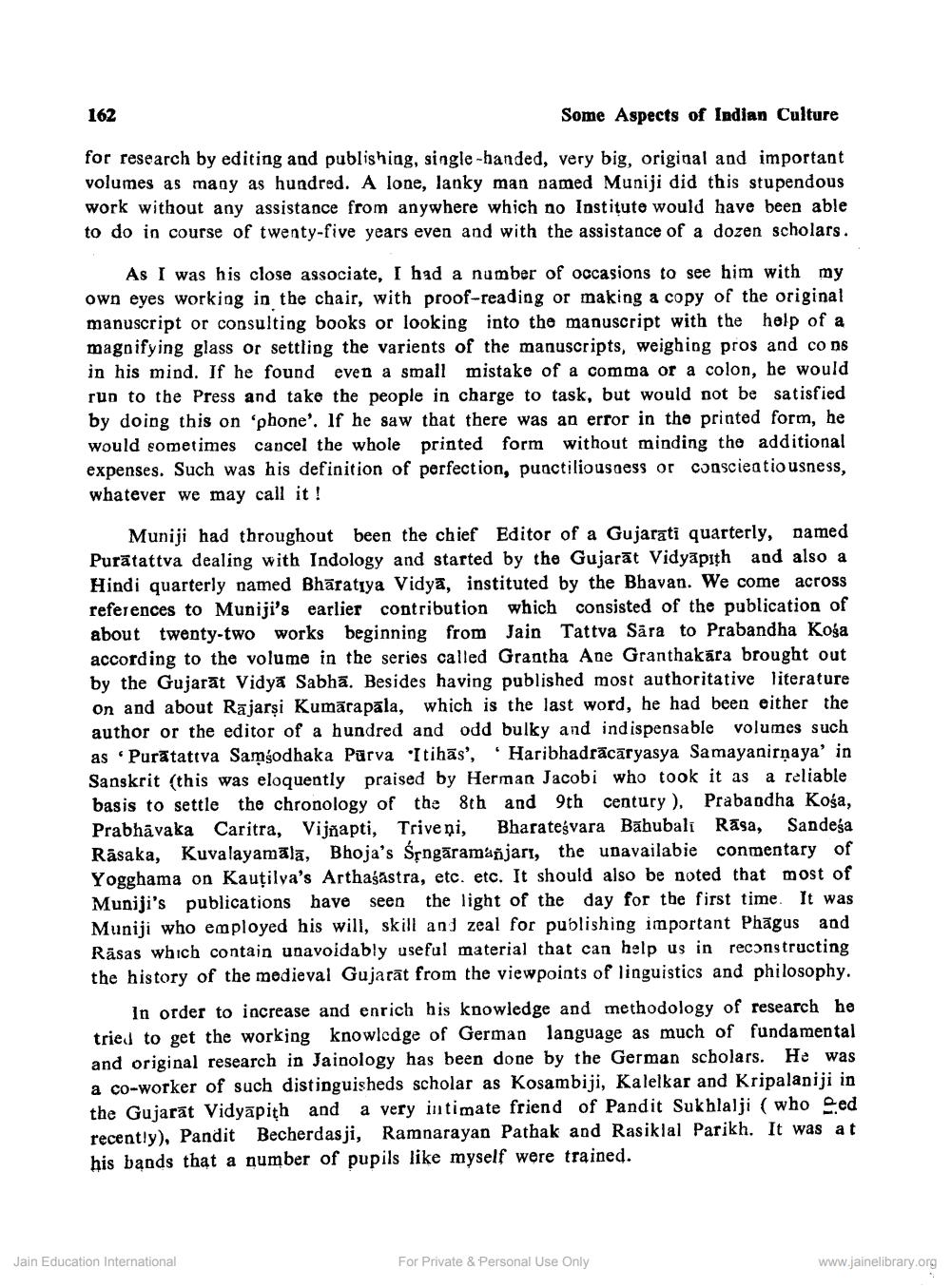________________
162
Some Aspects of Indian Culture
for research by editing and publishing, single-handed, very big, original and important volumes as many as hundred. A lone, lanky man named Muniji did this stupendous work without any assistance from anywhere which no Institute would have been able to do in course of twenty-five years even and with the assistance of a dozen scholars.
As I was his close associate, I had a number of occasions to see him with my own eyes working in the chair, with proof-reading or making a copy of the original manuscript or consulting books or looking into the manuscript with the help of a magnifying glass or settling the varients of the manuscripts, weighing pros and cons in his mind. If he found even a small mistake of a comma or a colon, he would run to the Press and take the people in charge to task, but would not be satisfied by doing this on 'phone'. If he saw that there was an error in the printed form, he would sometimes cancel the whole printed form without minding the additional expenses. Such was his definition of perfection, punctiliousness or conscieatiousness, whatever we may call it !
Muniji had throughout been the chief Editor of a Gujarati quarterly, named Purātattva dealing with Indology and started by the Gujarāt Vidyapith and also a Hindi quarterly named Bhāratiya Vidyā, instituted by the Bhavan. We come across references to Muniji's earlier contribution which consisted of the publication of about twenty-two works beginning from Jain Tattva Sāra to Prabandha Kosa according to the volume in the series called Grantha Ane Granthakāra brought out by the Gujarat Vidya Sabhā. Besides having published most authoritative literature On and about Rājarși Kumārapāla, which is the last word, he had been either the author or the editor of a hundred and odd bulky and indispensable volumes such as Purātativa Samgodhaka Purva Itihās', 'Haribhadrācāryasya Samayanirņaya' in Sanskrit (this was eloquently praised by Herman Jacobi who took it as a reliable basis to settle the chronology of the 8th and 9th century), Prabandha Koša, Prabhāvaka Caritra, Vijñapti, Triveņi, Bharateśvara Bahubali Rasa, Sandesa Rāsaka, Kuvalayamālā, Bhoja's Sțngāramañjarı, the unavailabie conmentary of Yogghama on Kautilya's Arthasastra, etc. etc. It should also be noted that most of Muniji's publications have seen the light of the day for the first time. It was Muniji who employed his will, skill ani zeal for publishing important Phāgus and Rāsas which contain unavoidably useful material that can help us in reconstructing the history of the medieval Gujarāt from the viewpoints of linguistics and philosophy.
In order to increase and enrich his knowledge and methodology of research he tried to get the working knowledge of German language as much of fundamental and original research in Jainology has been done by the German scholars. He was a co-worker of such distinguisheds scholar as Kosambiji, Kalelkar and Kripalaniji in the Gujarat Vidyāpith and a very intimate friend of Pandit Sukhlalji ( who sed recently), Pandit Becherdasji, Ramnarayan Pathak and Rasiklal Parikh. It was at his bands that a number of pupils like myself were trained.
Jain Education International
For Private & Personal Use Only
www.jainelibrary.org




